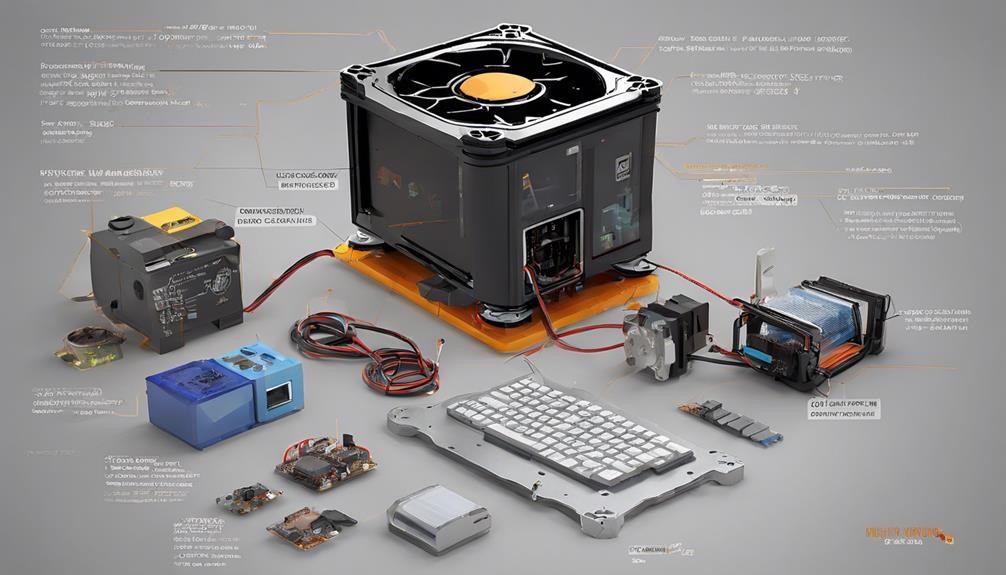You might think that operating a 3D printer is just a drop in the bucket when it comes to your electricity bill. However, a closer look at the power usage breakdown might surprise you. The revelation of which component consumes the most power could lead to some interesting cost-saving strategies for 3D printer users. Understanding how different parts of the printer contribute to overall energy consumption is not only enlightening but could also potentially impact your printing routine in more ways than one.
Ender 3 Power Consumption Breakdown

When analyzing the power consumption breakdown of the Ender 3 3D printer, it's evident that the bed heating component is the most energy-intensive part of the printing process. The heated bed consumes an average of 80 Watts at 60°C, spiking to 260 Watts during heating up. This translates to a total cost per hour of around 1.01 cents in the US.
Lowering the bed temperature or printing without heat can greatly reduce power consumption. In comparison, the nozzle power draw averages 30 Watts at 200°C, costing approximately 0.38 cents per hour.
Nozzle Power Draw Analysis
Analyzing the nozzle power draw of the 3D printer reveals its efficiency and cost-effectiveness compared to other components. The nozzle consumes around 30 Watts on average when printing at 200°C, with a peak of 50 Watts during heating. At an average cost per kWh, the hourly cost for the nozzle is approximately 0.38 cents in the US, 0.36 cents in the EU, and 0.45 cents in Asia.
Despite fluctuations between 20-40 Watts, the nozzle's power draw remains fairly stable. Compared to the heated bed, which consumes 80 Watts on average and peaks at 260 Watts, the nozzle is considerably more energy-efficient. Understanding the power usage of the nozzle can help you optimize printing costs and energy consumption efficiently.
Bed Heating Efficiency Insights

To gain insights into the efficiency of bed heating, consider the power consumption of the heated bed component in your 3D printer. The heated bed consumes an average of 80 Watts at 60°C, spiking to 260 Watts during the heating-up phase. It is the most energy-intensive part of the printer. Lowering the bed temperature or printing without heat can greatly reduce power consumption. When both the nozzle and bed are active, they consume a total of 110 Watts, leaving only 15 Watts for other printer components. The table below summarizes the power consumption details for the bed heating element:
| Heating Stage | Power Consumption (Watts) |
|---|---|
| Heating Up | 260 |
| Operating (60°C) | 80 |
| Total | 80-260 |
Frequently Asked Questions
How Does the Ender 3 Power Consumption Compare to Other 3D Printers?
When comparing Ender 3's power usage to other 3D printers, you'll find it consumes 125 Watts on average while printing. The bed and nozzle draw 80 and 30 Watts respectively. Adjusting settings can help manage overall power consumption.
Can the Power Consumption Be Reduced by Adjusting Printing Settings?
You can reduce power consumption by adjusting printing settings. Lowering bed temp or printing without heat helps. Nozzle and bed use 110 Watts, leaving 15 for other parts. Power draw: Ender 3 at 125 Watts average, 277 Watts max heating up.
What Is the Impact of Filament Type on Overall Power Usage?
When choosing filament, opt for lighter materials like PLA to lessen power use. Lighter filaments require less energy to heat up, reducing overall power consumption and costs. Selecting the right filament type can positively impact your printer's efficiency.
Are There Any Energy-Saving Tips Specific to Nozzle Power Draw?
When managing nozzle power draw, switch off nozzle heat when not needed. Minimize idle time to save electricity. Adjusting nozzle temperature slightly down can cut costs without compromising print quality. Remember, small changes lead to big savings!
How Does the Bed Heating Time Affect Energy Efficiency?
When the bed heating time decreases, you boost energy efficiency. Lowering bed temperature or printing without heat can cut power usage. The bed is the primary power hog, so optimizing its heating duration saves energy.
Conclusion
As you unplug your 3D printer after a long day of creating, remember the power-hungry heated bed and the efficient nozzle that brought your designs to life.
Just like balancing warm and cool colors in a painting, optimizing your printing settings can save energy and money.
So, next time you hit print, think about the power dynamics at play and make smarter choices for a more cost-effective and sustainable printing experience.